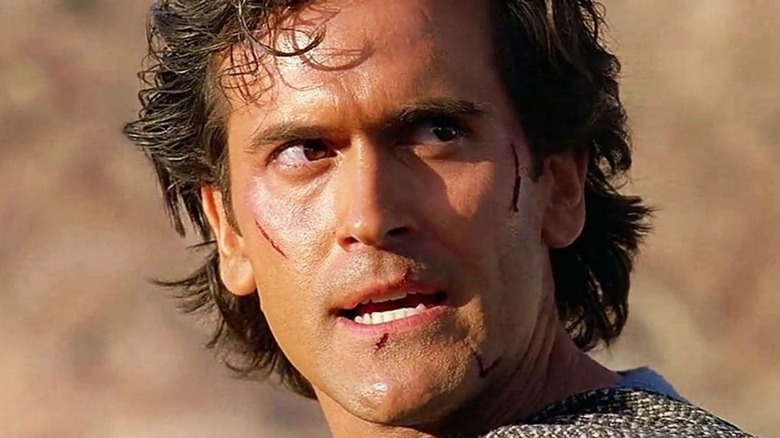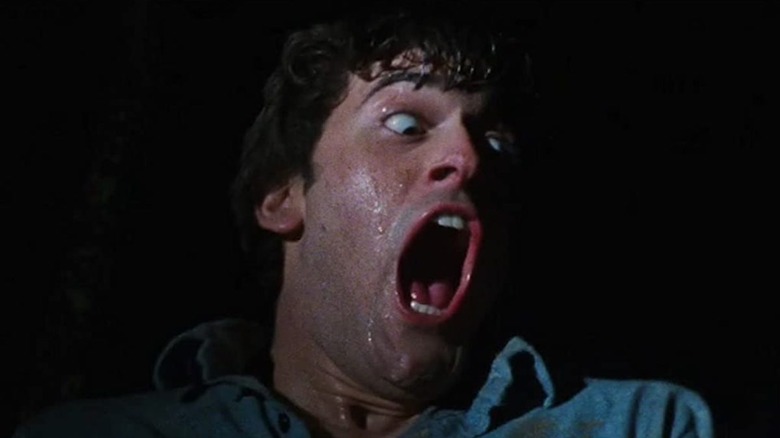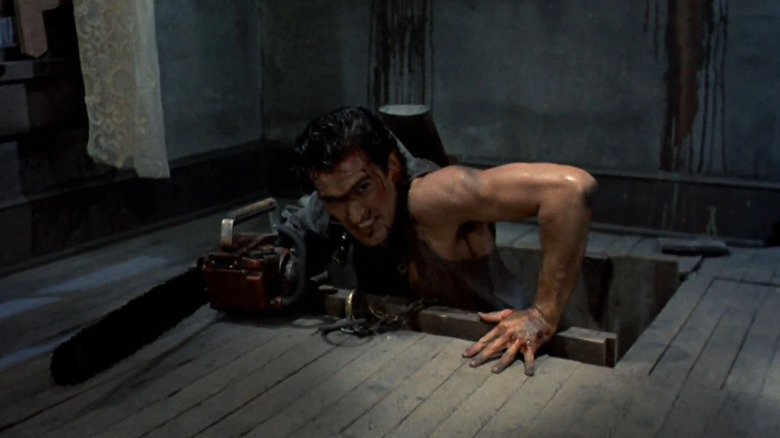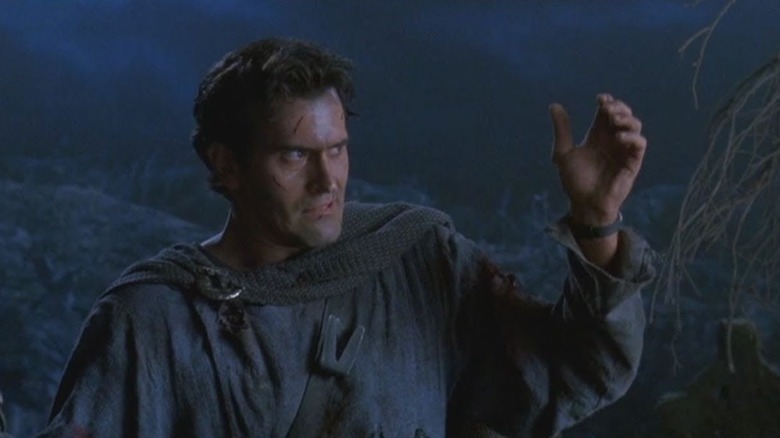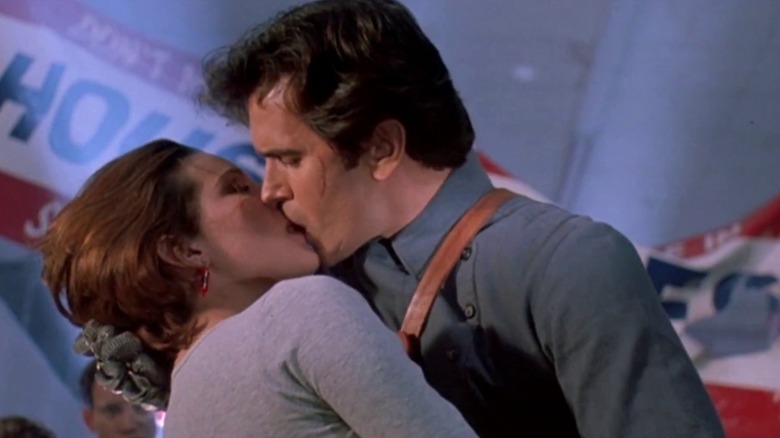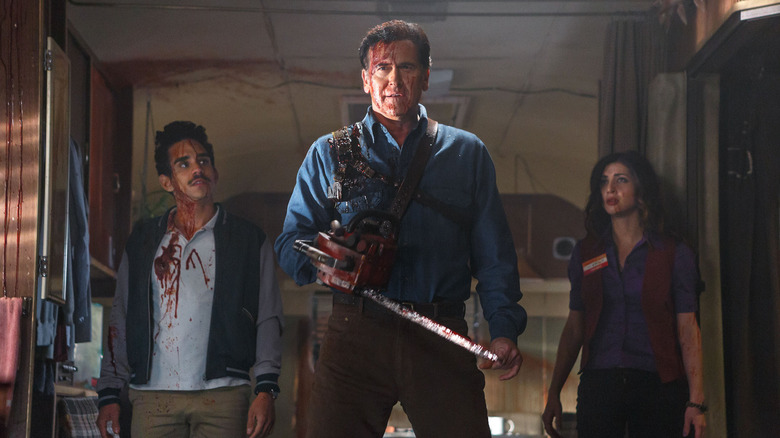How Army Of Darkness Completes Ash's Character Arc In The Evil Dead Trilogy
The "Evil Dead" trilogy is not particularly renowned for its strict continuity. Quite the contrary, actually — the three films, "The Evil Dead," "Evil Dead II," and "Army of Darkness," employ some notably loose connective tissue between each movie.
Some of this is due to the shifting creative approach, as the first film's ultimate experience in grueling terror morphs into the sequel's outrageous slapstick (or perhaps "splatstick" is a better term) before shifting completely into the period adventure comedy of "Army of Darkness." The continuity confusion also infamously stems from the films' production issues, with access to rights for recap footage requiring director Sam Raimi and company to reshoot and reconceive the backstory for each prior entry. There's also the fact that the "rules" Raimi establishes for the Deadites in the first "Evil Dead" are purposely vague, with victims being possessed and un-possessed seemingly at the drop of a hat, for instance.
Amongst all this, the "Evil Dead" trilogy still absolutely contains a sense of progression with each successive film — not necessarily one of plot or mythology but rather character, specifically that of protagonist Ash (Bruce Campbell). Despite all manner of continuity gaps, retconned backstory, and the like, Ash has a definitive character arc throughout the trilogy, and "Army of Darkness" acts as the culmination of his hero-ish journey, one way or another.
The Evil Dead: a hapless victim
To anyone who may have seen "Army of Darkness" before "The Evil Dead," Ash is borderline unrecognizable in the 1981 original. As Raimi, Campbell, and producer Rob Tapert sought to make a killing at the drive-in box office while conceiving and shooting the film in 1979, they were thinking of utilizing "The Texas Chain Saw Massacre" as well as the then-recently released "Alien" as templates, both of which whittle down an ensemble of friends (or co-workers) to leave a woman as the last person standing. Given that Campbell was elected to be the last survivor of the film (thanks in part to the movie becoming a lengthy and arduous shoot with a shrinking cast and crew), Ash is portrayed in a more feminine manner, contrasting with the overtly macho Scotty (Hal Delrich née Richard DeManincor).
Shy, romantic, sensitive, and completely unprepared for the bloody chaos that's unleashed by his innocent playing of a tape found in the basement of a cabin, Ashley in "The Evil Dead" follows what would become known as the "final girl" archetype, remaining in the margins of the story until there's no choice for him to step up and take action. Of course, he's also the very first example of a Raimi protagonist, which means he is made to suffer in all manner of ways, both physical and psychological. Though he goes from having various items of furniture falling on him during each demonic attack to brandishing a shotgun and burning the evil book of the dead Naturom Demonto, Ash's resilience is not rewarded a la Sally Hardesty or Ellen Ripley, and the still-roaming Evil Force consumes him.
Evil Dead II: the heroic loser
Or does it? Raimi, Campbell, and co-writer Scott Spiegel intended "Evil Dead II" to pick up almost right from where the first film left off, with Ash being thrown by that Evil Force rather than swallowed. However, due to not having the rights to re-use footage from the first film, it was decided to write and shoot a new recap, in which Ash's friends are conspicuously absent. Not only that, but this film's Ash is decidedly different from the start, boisterously cavorting with girlfriend Linda (Denise Bixler) before the demons are unleashed. One could say this is an Ash who's been merged with the old Scotty character — he's the one driving himself and Linda to the remote cabin in the woods, after all. Yet one could also say this is an Ash who retains the confidence he gained at the end of the first film, that attitude a little transposed to the recap sequence for brevity's sake.
In any case, Ash is viciously brutalized by the Deadites from the start, and over the course of the movie's reversed structure from the first film — Ash begins isolated and alone and is then joined by an ensemble of characters — the man changes from a tortured and mocked victim to a square-jawed, one-liner spouting '80s-style action hero. That change is a bit of a twist all by itself, as Raimi has Ash possessed by the Evil not once, but twice, seemingly hinting that the daughter of the cabin's owner, Annie (Sarah Berry) will take over as the movie's sole hero.
That sensitive, romantic man from the first film isn't completely gone, however, as Ash's love for his tragically departed Linda brings him back from the brink, allowing him to truly become — in his own words — "groovy."
Army of Darkness: from coward...
Raimi and company can't allow Ash to be victorious for long, though. In order to dispel the Evil Force, Ash and Annie read passages from the Necronomicon that opens up a time portal, sending Ash helplessly back to the Middle Ages. In the final moments of "Evil Dead II," the newly minted hero Ash finds being a prophesied savior a curse more than a blessing, with the denizens of Medieval times excitedly praising his arrival.
Beginning "Army of Darkness" with a new recap (featuring Bridget Fonda in the role of Linda this time) and a little bit of actual "Evil Dead II" footage, Ash mostly begins where he left off in the prior film, only his arrival in the kingdom of Lord Arthur (Marcus Gilbert) is not as welcoming as it was in part 2. While Ash is once again beaten, harangued and mocked (initially by the people of Arthur's land as well as the Deadites), he's no longer the innocent victim of the Evil Force. Now he's all too aware of the dangers inherent in tangling with Deadites and questing for the book of the dead, and his fear of the evil combined with his newfound heroism and fish-out-of-water status makes him behave like, as Arthur puts it, a "loudmouth braggart."
Despite all of Ash's bluster — toward the citizens of the kingdom, his new love interest, Shelia (Embeth Davidtz), and the Deadites themselves — he manages to screw everything up by inadvertently releasing the Evil, painting a target on the kingdom's back by bringing the Necronomicon to the castle, letting Shelia get kidnapped and cowardly demanding he be sent back to his own time.
...to king, baby
Yet hope exists for Ash to redeem himself, and nowhere is this more apparent than in Raimi and co-writer Ivan Raimi's choice to have the major villain of "Army of Darkness" be none other than Ash himself. A cloned evil twin of Ash, mind you, one that's fully given over to the Evil that thirsts for the Necronomicon. Even though the makeup for Evil Ash disguises Campbell's face, allowing for a degree of subtlety to be applied to the subtext, the battle between Ash and Evil Ash sees the character taking responsibility not just for his actions in "Army of Darkness" but for the entire "Evil Dead" trilogy. After all, though Scotty was involved and his friends were complicit, Ash did play the recording of the deadly incantations that began this entire mess.
In addition to facing his literal and figurative demons, Ash makes good on the promise made by the end of "Evil Dead II," becoming a fully-fledged action hero and buckling some swash to boot. Rousing the remaining members of Arthur's kingdom as well as convincing Duke Henry the Red (Richard Grove) to come to Arthur's aid, Ash proves himself to be a leader of men and an inspiration, defeating the Evil for good.
The many fates of Ash
Or does he? It wouldn't be "Evil Dead" without some ambiguity to the continuity, and the fate of Ashley J. Williams, S-Mart employee, is suitably varied. "Army of Darkness" is the only "Evil Dead" film to date that features multiple cuts of the movie with alternate endings, and Raimi's Director's Cut features Ash suffering a very familiar fate: he swallows one too many drops of magic liquid and wakes up a century beyond his own time, discovering that an apocalypse has befallen the Earth. With this ending, Ash is shown to be a character eternally doomed for his mistakes.
However, the Theatrical Cut's ending retains that theme with a decidedly less bleak edge. Ash is able to return to his own time (and his far less glamorous job at S-Mart) but, thanks to his buffoonery, has brought the Evil back with him. Yet his development over the three films means that, despite his responsibility, he is now adept and often victorious when forced to deal with Evil rearing its ugly head. The three-season sequel series "Ash vs. Evil Dead" picks up from this ending as well as this core definition of Ash's character, as he learns to incorporate new friends and old family members into his never-ending quest.
While it's difficult to claim any one "Evil Dead" film as the most popular, the version of Ash as a character that's the best known is undeniably the one from "Army of Darkness," proving how the film fully realizes and caps Ash's journey. While it's unlikely we'll see Ash again in the upcoming reboot (or is it a sequel? or rebootquel?!) "Evil Dead Rise," we can rest assured that, despite the "Evil Dead" franchise playing fast and loose with continuity, the heroic schmuck Ash continues to be rocksteady.
